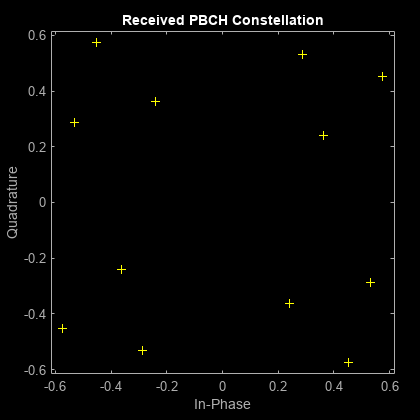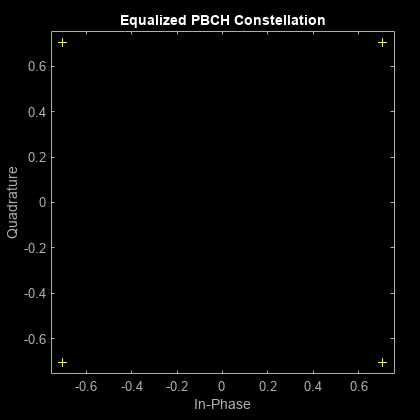Extract PBCH Symbols and Channel Estimates for Decoding
Extract physical broadcast channel (PBCH) symbols from a received grid and associated channel estimates in preparation for decoding a beamformed PBCH.
PBCH Coding and Beamforming
Create a random sequence of binary values corresponding to a BCH codeword. The length of the codeword is 864, as specified in TS 38.212 Section 7.1.5. Using the codeword, create symbols and indices for a PBCH transmission. Specify the physical layer cell identity number.
E = 864; cw = randi([0 1],E,1); ncellid = 17; v = 0; pbchTxSym = nrPBCH(cw,ncellid,v); pbchInd = nrPBCHIndices(ncellid);
Use nrExtractResources to create indices for the two transmit antennas of a beamformed PBCH. Use these indices to map the beamformed PBCH into the transmitter resource array.
carrier = nrCarrierConfig('NSizeGrid',20);
P = 2;
txGrid = nrResourceGrid(carrier,P);
F = [1 0.3i];
[~,bfInd] = nrExtractResources(pbchInd,txGrid);
txGrid(bfInd) = pbchTxSym*F;OFDM modulate the PBCH symbols mapped into the transmitter resource array.
txWaveform = nrOFDMModulate(carrier,txGrid);
PBCH Transmission and Decoding
Create and apply a channel matrix to the waveform. Receive the transmitted waveforms.
R = 3; H = dftmtx(max([P R])); H = H(1:P,1:R); H = H/norm(H); rxWaveform = txWaveform*H;
Create channel estimates including beamforming.
hEstGrid = repmat(permute(H.'*F.',[3 4 1 2]),[240 4]); nEst = 0;
Demodulate the received waveform using orthogonal frequency division multiplexing (OFDM).
rxGrid = nrOFDMDemodulate(carrier,rxWaveform);
In preparation for PBCH decoding, extract symbols from the received grid and the channel estimate grid.
[pbchRxSym,pbchHestSym] = nrExtractResources(pbchInd,rxGrid,hEstGrid); scatterplot(pbchRxSym(:),[],[],'y+'); title('Received PBCH Constellation');

Equalize the symbols by performing MMSE equalization on the extracted resources. Plot the results.
pbchEqSym = nrEqualizeMMSE(pbchRxSym,pbchHestSym,nEst); scatterplot(pbchEqSym(:),[],[],'y+'); title('Equalized PBCH Constellation');

Retrieve soft bits by performing PBCH decoding on the equalized symbols.
pbchBits = nrPBCHDecode(pbchEqSym,ncellid,v)
pbchBits = 864×1
1010 ×
-2.0000
-2.0000
2.0000
-2.0000
-2.0000
2.0000
2.0000
-2.0000
-2.0000
-2.0000
⋮
